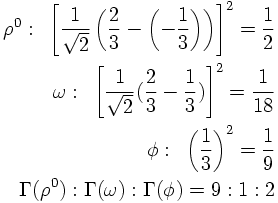The 'OZI rule' has been invented independently by Okubo, Zweik and Iizuka.
The OZI rule 'explains' why the vector meson φ (JPC=1--), which has as dominant quark content s anti-s, decays dominantly in K anti-K meson pairs whereas the decay in three pions is suppressed although the phase space in the latter case is much larger.
The values for the branching fractions can be found on the PDG homepage.
OZI RULE
The diagrams in terms of quark lines are depicted in

The OZI rule states that the final states with a kaon-anti-kaon pair are favored without giving a dynamical explanation. Since the phase space for these decays is quite small the decay rate for the φ is rather small explaining why its width (4.26 MeV) is much smaller than the ones of typical hadrons resonances like the ρ width (125 MeV).
SIDEREMARK 1:
The decay into two pions is forbidden since the two pions have to be in an angular state with L=1. That is, the space part of the wave function is anti-symmetric. Since the intial state has isospin 0 the two pions have to carry isospin 0 as well. The isospin wave function of two isospin 1 particles with third component +1 and -1, respectively, forming an isospin 0 state is symmetric.
As a consequence, the total wave function of the two identical bosons would be anti-symmetric!
A simpler explanation of the selection rule could be given by introducing the concept of G-parity which is not subject of this chapter.
SIDEREMARK 2:
One can interpret the fact that the φ is dominatly decaying into kaon pairs also as evidence that the quark content is s anti-s.
Another argument for the quark content assigned to the neutral vector mesons ρ,ω and φ is:


Under the assumption that the ratio

This leads to the prediction:

SIDEREMARK 3:
One might ask why the φ decays into charged and neutral hadron pairs have significantly different branching fractions. Their relative ratio is 0.492/0.337.
Due to the difference in mass between charged and neutral kaons and due to the small phase space the final state momenta are significantly different in both decays (127 MeV and 110 MeV, respectively). The phase space scales linearly with the kaon momentum in the final state which would explain a 15 percent difference.
There is however an additional factor:
Since the φ is a vector particle and the kaons are pseudo-scalar mesons they are in a final state with angular momentum L=1. This leads to an additional factor p2L in the decay rate.
As a consequence, the ratio of branching fractions scale like (127 MeV/110 MeV)3 which is approximately 1.5!